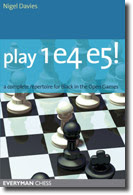Book Reviews
No. 7

Play 1 e4 e5!
A Complete Repertoire For Black In The Open Games
By GM Nigel Davies
Everyman Chess
In the introduction, Nigel Davies explains his reasoning behind taking up 1...e5, the most classical reply to White’s most popular opening move. He explains how he himself switched from his former favourite Pirc/Modern complex when Lev Psakhis told him that the study of the Ruy Lopez was essential to developing the game of any chess player, and that the great Polugaevsky lacked such a grounding and therefore suffered due to the lack of it.
He is right when he says the average club player is put off defending 1...e5 by the shear amount of options open to White, from the Ruy Lopez to all the old gambits.
In fact, the old gambits have all been defused by modern theory and well-versed Black players should be delighted to see them appear over the board. The biggest problem must surely be how to tackle the Ruy Lopez and I was intrigued to see which line Davies would recommend.
Just over half of the 192 pages are devoted to the Lopez. The recommended repertoire focuses on the Closed Lopez in general and specifically the Keres Variation.
This goes:
1 e4 e5 3 Nf3 Nc6 3 Bb5 a6 4 Ba4 Nf6 5 0-0 Be7 6 Re1 b5 7 Bb3 d6 8 c3 0-0 9 h3 Na5 10 Bc2 c5 11 d4 Nd7

Keres prepared the idea for the 1962 Curacao tournament. It has some advantages and disadvantages over other lines. For example, by defending e5 with the Knight, the Black Queen is given more freedom in comparison with the variations when she slips to c7 and the Bishop can go to f6 to apply more pressure to the very important d4 point. One downside would be the lack of control over certain White squares - namely f5 and d5 - which could be useful targets for a White Knight.
I think that this is possibly the major selling point of the book. Two famous 1...e5 repertoire books have covered everything except the Ruy Lopez (‘Understanding the Open Games’ by Soltis, Mednis et al and ‘Play The Open Games As Black’ by John Emms). They are both excellent books but it is clearly more appealing to have an all-inclusive repertoire in a single book.
The illustrative games are well chosen and show the likes of Ponomariov, Graf and Keres defending the Black side of the debate. There are several games by Davies himself, which is a good thing, because I firmly believe that chess authors should practice what they preach.
There are five chapters on the Ruy Lopez. In addition to covering the Keres Variation, Davies recommends line against the early White deviations such as the DERLD and the Exchange Variation. Never heard of the DERLD? It’s an acronym for the Delayed Exchange Ruy Lopez Deferred, which players of a certain age may remember being enthusiastically touted in a Len Pickett monograph.
The Exchange Variation will put many players off 1...e5, at least as a winning attempt. Davies tries to pep things up for Black with 5...Qf6, which leads to more unusual paths than the main lines and has been holding up well in Grandmaster play.

Of course the author doesn’t claim to be able to gain an advantage as Black but he does supply enough ammunition to be able the studious reader to battle against the ‘Spanish Torture’.
The second half of the book deals with all of the other White options.
The combative Two Knights’ Defence is given good coverage, though in it’s more usual form and not the ultra-sharp Traxler variation.
9 Nh3!?, championed by Steinitz, Fischer and Short, is roughed up by 9...g5!? in a game Grischuk -Malaniuk…

…in which White could find nothing better than rerouting the Knight to f3 via g1 on moves 12 and 13.
Following a chapter on the popular Scotch game, the book rounds off with chapters on White’s other second and third move options. I was a bit surprised to see 2 …Bc5 recommended against the King’s Gambit as I always thought White gained a pleasant edge in the ensuing variations. However, the main illustrative game is once again one of the author’s own, so it is clearly a line he his happy with.
VERDICT: An all-encompassing 1 e4 e5 book is a rare beast indeed. This has the advantage on previous works of giving the Ruy Lopez full coverage. The lines given certainly look good enough to make up a repertoire but I would recommend a bit more background reading on the early deviations to go with it. On the whole, if you fancy a change for the New Year, you could do a lot worse than give this book a try.
For details of Everyman chess books, please visit:
http://www.everymanchess.com/
Happy reading!
December 2005



